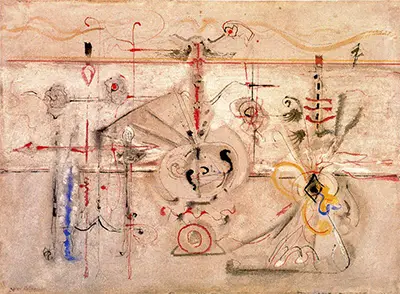Rothko was actually highly skilled at a watercolorist and used those techniques here to produce this Surrealist artwork. At this point in his career the artist was known to be looking at art as a means to explore and experiment, not simply to mimic and we can see a clear example of that here. The artist is known to have been considering the themes of creation and origin whilst putting this intriguing piece together. We can perhaps see elements of traditional African art here, or even primaeval cave paintings, where detail is reduced down to simple shapes and lines. He would probably have taken influence from European artists here as well, who were also starting to move towards a greater use of abstraction.
During the 1940s Rothko's imagery became increasingly symbolic. In the social climate of anxiety that dominated the late 1930s and the years of World War II, images from everyday life - however unnaturalistic - began to appear somewhat outmoded. If art were to express the tragedy of the human condition, Rothko felt, new subjects and a new idiom had to be found. He is quoted as having expained that:
"...It was with the utmost reluctance that I found the figure could not serve my purposes…. But a time came when none of us could use the figure without mutilating it."
Rothko's early expressionist paintings on everyday subjects reflected Max Weber's influence as well as that of artists such as Marc Chagall and Chaim Soutine. It would be later that his abstract work helped him achieve such incredible fame, but those were completely disconnected from reality. Instead, his Color Field paintings would immerse the viewer in a world of colour and space, where these huge canvases would cover all of their peripheral vision and force them into Rothko's new world. That contrasts considerably with his Surrealist artworks, such as Archaic Idol, and perhaps explains why so many of his abstract paintings were actually left completely untitled, or with simple names that just captured the precise colour palette being used in each case. All that said, Rothko actually named a number of different artworks with the same title of Archaic Idol, all of which were fairly similar but far from identical. One of the others can now be found in the collection of MoMA.

